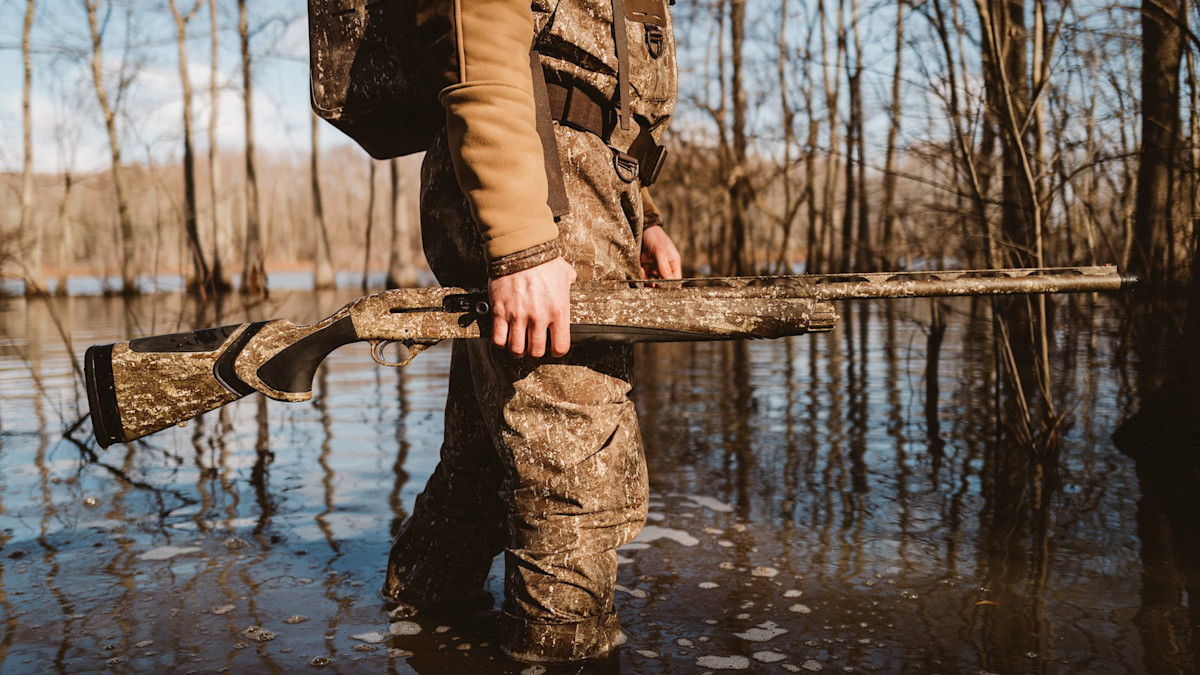
The fascinating thing about shotguns is you never really know how one will pattern a shotshell until you pull the trigger and see the results on target paper. A shotshell delivers hundreds of projectiles downrange at the same time. Once these pellets, which vary in size and are comprised of different metals (lead, steel, bismuth, tungsten, and others), leave the muzzle, they become exposed to gravity, elevation, temperature, wind, and other elements, all of which affect their trajectory.
If you have ever heard someone say, “No shotgun produces the same pattern twice,” that’s correct. For instance, a 3” load of No. 4 steel with a 1⅜-ounce payload contains 263 pellets. It would be impossible to replicate the exact pattern with that many projectiles over and over again.
Since you can’t “zero” a shotgun like a rifle (unless you’re shooting slugs), it has perpetuated several myths about shotguns, shotshells, and their capabilities. The drop of a bullet tells a rifle shooter what their load is doing from the time it exits the muzzle until it strikes the target. However, there is no equation that can determine what 263 pellets are doing in the space between the shotgun muzzle and the target. That unknown has created many ballistic hypotheses passed off as fact.
The Truth About Shotstrings
If you are one of the few hunters or clay-target shooters who consistently pattern-test your shotgun, you have seen what it is capable of on paper. However, one of the misconceptions is that the pellets in that pattern are all delivered to the target the exact same way, whether you’re shooting a stationary or moving target.
Bob Brister, the late Field & Stream shooting editor, proved otherwise by using an unconventional (but innovative) method of testing. He affixed a very long (and large) piece of paper to a wooden patternboard mounted on a trailer. Brister hooked up the trailer to the family station wagon and had his wife drive past his shooting position at various speeds.
As the target rolled by, Brister would put the bead of the shotgun on the leading edge of a bird-shaped target at the front of the patternboard and pull the trigger. This simulated a hunter swinging on a passing duck or other game bird. He found that the pattern impacted much differently at various points on the paper. The pellets were strung out horizontally across the target. This revealed that patterning your shotgun tells you its point of impact, but it does not produce that same pattern on a stationary versus a moving target.
Tight Chokes Yield Better Patterns
Many duck hunters believe a tight choke is the most effective choice for clean kills. To a certain extent, a tighter choke will indeed yield a tighter pattern (there is a threshold, especially for larger shot sizes), but it may not increase your accuracy. The tighter the pattern, the less room for error the shooter has, which is why many skeet and other clay-target shooters use open chokes.
If a drake mallard is dropping into the decoys at 20 yards and you shoot slightly behind it using a full choke, the pellets may only fringe the bird, possibly crippling or wounding it. A more open choke allows the pattern to expand rapidly as the payload exits the muzzle, casting a wider net.
The denser the shot, the tighter your pattern will be. For example, if you shoot four different loads of No. 6 steel, bismuth, lead, and tungsten super shot (TSS) through a modified choke from 40 yards, each pattern will get tighter. Steel is the lightest shot at 7.8 grams per cubic centimeter (g/cc) with TSS being the most dense at 18.1 g/cc. The light weight of steel makes it much harder for the pellets to cut through the air on the way to impact.
This dispels a common notion that steel patterns are tighter than lead patterns. Many hunters think this because steel waterfowl loads are built with larger shot sizes to compensate for their lack of density. If you shoot a No. 2 steel load against a No. 4 lead load at the same distance through the same choke, the steel load’s pattern will almost always be tighter.
Speed Kills
For a time, non-toxic shotshell makers were speeding up muzzle velocities to over 1,500 feet per second (fps), thinking that faster pellets would hit with more force upon impact. However, ballistics expert Tom Roster found that once you increase velocities past 1,425 fps most non-toxic shotshells (steel, bismuth, Hevi-Shot, and TSS) see a decrease in pattern density and downrange effectiveness. Shooters will also likely experience more felt recoil as powders must burn hotter to push the payload down the bore faster.
Roster found that a 2¾” steel, bismuth, and Hevi-shot shotshells can kill ducks (except sea ducks) out to 50 yards with 95% effectiveness. His data showed that no larger than a 3” load is needed to kill geese at 50 yards, and that a 3½” shotshell is optimal for geese past that distance due to the fact that it can hold more pellets.
Last Shot
Waterfowl seasons are fast approaching, and in some cases, they’re already here. As you look forward to chasing ducks and geese this year, take some time to review your shotgun and shotshell setup to make sure it’s working the way you expect. Bagging a limit is tough work–you might as well give yourself every advantage you can.
For more info on shotguns and shotshells, check out these articles: 5 Shotgun Drills to Get Ready for Fall, 12 Gauge vs. 20 Gauge, and Shotgun Shells and Shot Size: Everything You Need to Know.






